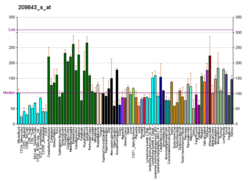Mokhtarzadeh Khanghahi A, Satarian L, Deng W, Baharvand H, Javan M. In vivo conversion of astrocytes into oligodendrocyte lineage cells with transcription factor Sox10; Promise for myelin repair in multiple sclerosis. PLoS One. 2018;13(9):e0203785
We have known for years that neural stems cells form astrocytes and that these can be pushed to become nerves or oligodendrocytes. In this study they deliver just one transcription factor called Sox-10 and it drives astrocytes down this pathway
| SOX10 | |||||||||||||||||||||||||
|---|---|---|---|---|---|---|---|---|---|---|---|---|---|---|---|---|---|---|---|---|---|---|---|---|---|
| Identifiers | |||||||||||||||||||||||||
| Aliases | SOX10, DOM, PCWH, WS2E, WS4, WS4C, SRY-box 10 | ||||||||||||||||||||||||
| |||||||||||||||||||||||||
| |||||||||||||||||||||||||
ABSTRACT
Recent studies demonstrate that astroglial cells can be directly converted into functional neurons or oligodendrocytes. Here, we report that a single transcription factor Sox10 could reprogram astrocytes into oligodendrocyte-like cells, in vivo. For transdifferentiation, Sox10-GFP expressing viral particles were injected into cuprizone-induced demyelinated mice brains after which we assessed for the presence of specific oligodendrocyte lineage cell markers by immunohistofluorescence (IHF). As control, another group of demyelinated mice received GFP expressing viral particles. After 3 weeks, the majority of transduced (GFP+) cells in animals which received control vector were astrocytes, while in animals which received Sox10-GFP vector, the main population of GFP+ cells were positive for oligodendrocyte lineage markers. We also extracted primary astrocytes from mouse pups and purified them. Primary astrocytes were transduced in vitro and then transplanted into demyelinated brains for later fate mapping. After three weeks, in vitro transduced and then transplanted astrocytes showed oligodendrocyte progenitor and mature oligodendrocyte markers. Further confirmation was done by transduction of astrocytes with lentiviral particles that expressed Sox10 and GFP and their culture in the oligodendrocyte progenitor medium. The induced cells expressed oligodendrocyte progenitor cells (iOPCs) markers. Our findings showed the feasibility of reprogramming of astrocytes into oligodendrocyte-like cells in vivo, by using a single transcription factor, Sox10. This finding suggested a master regulatory role for Sox10 which enabled astrocytes to change their fate to OPC-like cells and establish an oligodendroglial phenotype. We hope this approach lead to effective myelin repair in patients suffering from myelination deficit.The experiment that needs to be done is to take gliotic lesions and see if this can be used to promote demyelination in chronic lesions. If it can we may be on to something
Oligodendrocyte-encoded Kir4.1 function is required for axonal integrity.Schirmer L, Möbius W, Zhao C, Cruz-Herranz A, Ben Haim L, Cordano C, Shiow LR, Kelley KW, Sadowski B, Timmons G, Pröbstel AK, Wright JN, Sin JH, Devereux M, Morrison DE, Chang SM, Sabeur K, Green A, Nave KA, Franklin RJ, Rowitch DH.Elife. 2018 Sep 11;7. pii: e36428. doi: 10.7554/eLife.36428. [Epub ahead of print]
Glial support is critical for normal axon function and can become dysregulated in white matter (WM) disease. In humans, loss-of-function mutations of KCNJ10, which encodes the inward-rectifying potassium channel KIR4.1, causes seizures and progressive neurological decline. We investigated Kir4.1 functions in oligodendrocytes (OLs) during development, adulthood and after WM injury. We observed that Kir4.1 channels localized to perinodal areas and the inner myelin tongue, suggesting roles in juxta-axonal K+removal. Conditional knockout (cKO) of OL-Kcnj10 resulted in late onset mitochondrial damage and axonal degeneration. This was accompanied by neuronal loss and neuro-axonal dysfunction in adult OL-Kcnj10 cKO mice as shown by delayed visual evoked potentials, inner retinal thinning and progressive motor deficits. Axon pathologies in OL-Kcnj10 cKO were exacerbated after WM injury in the spinal cord. Our findings point towards a critical role of OL-Kir4.1 for long-term maintenance of axon function and integrity during adulthood and after WM injury.
KCNJ10 This gene encodes a member of the inward rectifier-type potassium channel family, Kir4.1, characterized by having a greater tendency to allow potassium to flow into, rather than out of, a cell. Kir4.1, may be responsible for the potassium buffering action of glial cells in the brain. It is highly expressed on astrocytes. However in oligodendrocytes it helps them help nerves to survive. Loose it and nerves dies eventually. Interesting science but one may need an alternative route to use therapeuticaly as this potassium channel is all over the place. Many years ago there was a claim that people with MS had antibodies against this channel. It was refuted by most other studies




